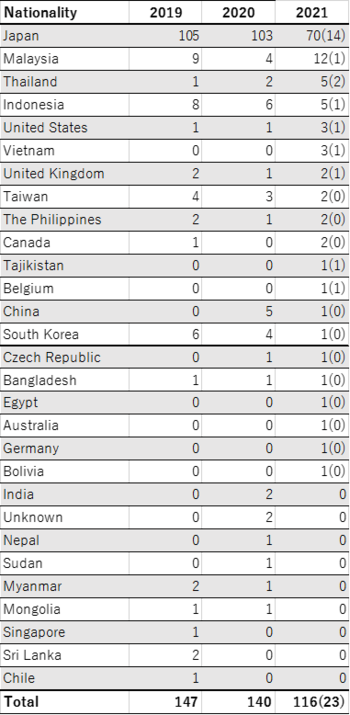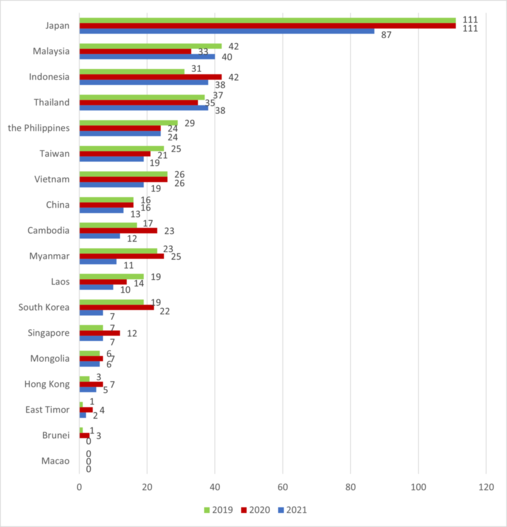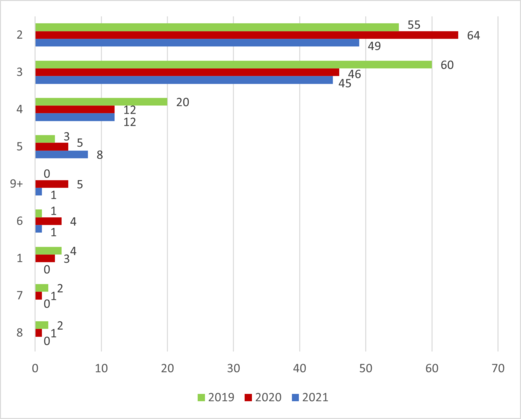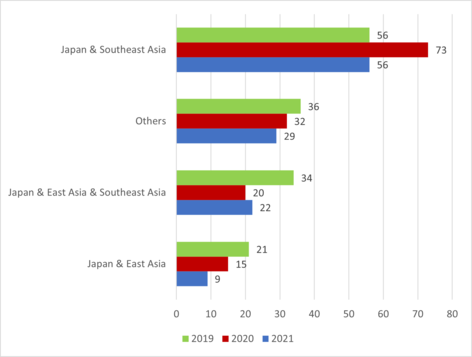Selection Committee Chair Prof. Shigeto Sonoda
Outline of Fiscal 2021 International Grant Program “Cultivating Empathy Through Learning from Our Neighbors: Practitioners’ Exchange on Common Issues in Asia”
This is the third time for me to provide commentary on the selection results, following fiscal 2019 and fiscal 2020.
During this time, we made minor changes to the way we call for applications for the International Grant Program. The prioritized area, which was introduced in fiscal 2019, was abolished in fiscal 2020, making the program completely open to applications on various issues. In fiscal 2021, we introduced the One-Year Grant to call for proposals on projects based on fresh ideas focused on online activities, which can be undertaking without requiring the cross-border movement of people. However, the key points of the International Grant Program remain unchanged. Its purpose is to support projects that are aimed at solving common issues in Asia through learning from our neighbors and which include the following Four Elements. The total budget also remains unchanged at 70,000,000 yen.
(1) Transnationality: The project must cover at least two countries in East Asia and/or Southeast Asia, and the project members must also be from at least two countries. In addition, any achievement made through the project must cover multiple countries.
(2) Cross Sectoral Approach: A sufficient number of experts from multiple sectors (such as researchers, NPO staff, businesspersons, and government officials), who are needed to solve the problem, must be participating in the project under an organic relationship.
(3) Mutual Learning: Project participants must build a relationship of mutual learning to carry out the project.
(4) Foresight: The project must reflect a strong awareness of its outcomes and must consider the impact it will have after the end of the grant and the possibility of its future development. It should also cover problems that could occur in the future and reflect a new perspective beyond conventional frameworks.
Overview of the Situation and Details of Application
The open call for proposals began on April 1, 2021, and applications were accepted until June 5. Last fiscal year, the application procedure started slightly later than usual due to the COVID-19 pandemic. This year, the application window was the same as before.
Among those who sought prior consultation, there were several applicants wondering whether to apply for the Two-Year Grant or One-Year Grant. It seems that many applicants were wondering on what scale they should implement their projects and how to manage the schedule given the uncertainty about the future course of the COVID-19 pandemic.
Unfortunately, the number of applications for the new One-Year Grant was 23, which was not as large as we expected. Meanwhile, the number of applications for the Two-Year Grant was 93, or around two-thirds of the usual number. As a result, the total number was just 116. Among them, the number of applicants who had undertaking projects with grants from the Toyota Foundation was 15 (12.9%), not significantly different from the last year's rate (15%).
As for the distribution of nationalities of applicants, no major change was seen in the last three years (see Table 1). Because of the condition that applicants have their main residence in Japan, around 70% of the applicants were Japanese. This trend is also seen among applicants for the One-Year Grant. As a whole, the number of applications from applicants of Southeast Asian nationalities has increased while that of applicants holding East Asian nationalities has been decreasing. This is also influencing the distribution of targeted countries, which will be described below (see Fig. 1).
Table 1: Distribution of the nationalities of applicants for fiscal 2019, 2020 and 2021

Countries/regions covered by the proposed projects (Fig.1), their numbers (Fig.2) and their combination (Fig.3) show that the ratio of proposed projects targeting Southeast Asian countries/regions has seen a relative increase, while the ratio of projects targeting Japan and East Asia or only East Asia excluding Japan has decreased. Further, the number of proposals on projects targeting a wide area covering six or more countries/regions has decreased, which gives the impression that the number of more modest projects has grown relatively large. Keywords written on the application forms were as diverse as human rights protection, food safety, environmental preservation and sustainability, tourism, poverty and inequalities, disaster prevention, resource management, aging, and medical aid. There were more cases than last year in which the COVID-19 pandemic was referred to in the project explanation. This reflects the increase in the number of applicants who set a mission to solve a common issue in Asia that has emerged (or become more serious) as a result of the COVID-19 pandemic.
Fig. 1: Targeted countries/regions that were stated in application forms for 2019, 2020 and 2021
(Excluding countries/regions outside East and Southeast Asia)

Fig. 2: Numbers of targeted countries/regions that were stated in application forms in 2019, 2020 and 2021
(Excluding countries/regions outside East and Southeast Asia)

Figure 3 shows the distribution of targeted countries/regions stated in applications. The number of applications targeting Japan was 111, similar to the previous fiscal year, which reflects the large number of applications from Japanese applicants. Looking closely at the proposed projects targeting both Japan and Southeast Asia, more proposals targeted Indonesia while less focused on Malaysia: there were slight changes within the applications involving Southeast Asia.
Fig. 3: Combinations of targeted countries/regions that were stated in application forms for 2019, 2020 and 2021
(Excluding countries/regions outside East and Southeast Asia)

Applications were found to describe diverse projects, which contained many different factors, such as multicultural coexistence, gender, environmental preservation, sustainability, conservation of cultural properties, tourism, education, poverty and disparities, disaster prevention, food safety, resource management, community construction, and aging.
Selection process and results
The selection committee was made up of four members including the committee chair. All of them have continued in their positions from the previous fiscal year. This enabled selection to be completed even more smoothly than last year.
First, Program officers (POs) closely reviewed the 116 applications individually. They eliminated incomplete application forms and applications that were judged not to include the Four Elements described above, before they asked each committee member to evaluate the remaining applications.
The four committee members read the applications carefully, and recommended nine projects in total, assuming three for the One-Year Grant and six for the Two-Year Grant based on the number of selected projects in recent years. Each member gave a weight on a small number of the projects that he or she strongly recommended and added their own personal comments.
If a member of the selection committee had any question about the content, schedule, budget plan, or other matters, or expected difficulties in the implementation of the proposal, he or she informed the POs, who communicated the questions/concerns to the applicants and received replies before they participated in the selection committee meeting.
At the end of the selection process, the results of the reviews by the four committee members were summarized, and a selection committee meeting was held. At the meeting, the committee eliminated applications that had not been recommended by anyone at all. All members commented on applications that at least one of the members had recommended, and they discussed those applications one by one. They made the final decision on the winning projects by considering the balance among the countries/regions covered and project themes, the One-Year Grant and Two-Year Grant proportion, and by adjusting the amounts of grants so that the total amount would not exceed 70,000,000 yen.
The ten projects selected for this fiscal year (three for the One-Year Grant and seven for the Two-Year Grant) have the following characteristics.
First, all the representatives of the selected projects are Japanese again. While there had been several non-Japanese representatives of selected projects in each year before 2019, there was no such representative among projects selected in 2019. This time again, all the representatives are Japanese, as in 2019. It is possible that the COVID-19 pandemic has made it difficult to reach out to non-Japanese applicants, and the foundation may have to consider a measure for this in the future.
Second, the number of projects covering East Asian countries/regions has increased. In 2019, one project targeting South Korea and one targeting Taiwan were selected. No project targeting East Asian countries/regions was selected in 2020. This year saw an increase in such projects, with one targeting South Korea, three targeting Taiwan, and one targeting China among the selected projects. On the other hand, projects targeting Southeast Asian countries/regions such as Indonesia, Malaysia, and Myanmar, which were among selected projects in the past two years, are not included in the projects selected this year. In terms of applicants' nationalities, while the number of applications from Southeast Asians saw a relative increase, the number of selected projects decreased.
Projects targeting the combination of “Japan, East Asia, and Southeast Asia” and those targeting the combination of “Japan and East Asia”, none of which was selected last year, were among the winning projects this year, with their numbers being two and three, respectively, while projects for linking “Japan and Southeast Asia” and the ones linking countries and regions in Southeast Asia were also selected as usual. Above all, three projects for linking Japan and Taiwan were selected, underscoring the strength of the ties between Japan and Taiwan in the COVID-19 pandemic. The number of applications stating the combination of Japan and East Asia decreased to nine, but the above result means that contents of those applications were evaluated highly by the selection committee.
Third, a high selection rate for applicants who had undertaken projects with grants from the Toyota Foundation, which was pointed out in the preceding years, is not seen this time. Last year, "Of the 140 applications, 21 proposals were made by those who had received grants from the foundation in the past. Three of the 21 proposals were selected: the rate of selection is 14.3%. On the other hand, six proposals (5%) were selected from 119 applications made by those who had not received grants from the foundation" (quoted from the outline I wrote last year). This year, however, 16 of the 116 proposals were made by representatives or members of projects which were undertaken with grants from the Toyota Foundation. And only one of the 16 proposed projects was selected, resulting in a decline of the selection rate by half, to 6.3%. On the other hand, nine proposals (9%) were selected from 100 applications made by those who had not received grants from the foundation: the result is quite different from last year's.
While no project related to environmental preservation/sustainability was selected last year, three such projects were selected this fiscal year. On the other hand, no project related to tourism was selected this fiscal year, although at least one such project had been selected every recent year. Further, only one project related to immigrants was selected this year while three and two such projects were selected last year and year before last, respectively, partly because the theme fell under a prioritized area.
As described above, trends in applications and the features of selected projects for this fiscal year seem to have been slightly different from those for the last fiscal year.
Introducing Adopted Projects
The following are two projects that received a relatively high evaluation, one each from among winners of the Two-Year Grant and those of the One-Year Grant. Japan happens to be included among the targets of these projects, but there are two other projects which do not target Japan.
| Saya Yukimoto, “Building a simultaneous solution system for climate change and poverty - applying the "+- model" of Taiwan in Thailand and Japan” |
| Countries: Japan, Taiwan, and Thailand |
| Term: 2 years |
| Amount: 9,700,000 yen |
A factor which has seen climate change (global warming) spin out of control is the apathy of the poorer population and businesses that cannot afford to think about the problem. Based on this understanding, this project will apply the "-+ Model" that was developed in Taiwan (a system in which negative factors are changed into positive factors through a behavioral chain, such as requesting businesses to digitalize invoices and receipts and donate the money thus saved to replace lights of poor households with LED and returning the money thus saved to such households). The project will be implemented in collaboration with the city governments of Kyoto and Bangkok. The above model will be modified in the program of each city by adjusting it to the local conditions. What makes this project praiseworthy is not only the idea of applying the system transformation to local municipalities but also the plan to expand a successful example in Taiwan by reflecting local conditions. This project will be even more attractive if it becomes possible to externally disclose and communicate the process as well.
| Yuichi Tomohiro, Representative Director, General Incorporated Association TSUMUGIYA |
| Cultivating intermediate players who can coordinate local resources and creating a learning platform across countries/sectors through a designers’ residency program |
| Target Countries and Regions: Indonesia, Cambodia, Vietnam, Taiwan, [India], Thailand, Philippines, |
| Malaysia, and Japan |
| Grant Period: two years |
| Grant Amounts: 9.0 million yen |
This program is aimed at further empowering citizen journalism and independent media. It solicits participants via social media or other means, aiming to encourage them to acquire detailed storytelling techniques through online seminars, workshops, and trial production of videos. Mr. Morita implemented a similar project in five countries during 2016 to 2019. Taking advantage of this experience, he has planned to implement the project by narrowing the target countries to Japan, Cambodia, and the Philippines.
Applications strongly appealed to the selection committee if applicants understood the foundation's missions and characteristics and the goals of the International Grant Program, even if the applicants have not received the Toyota Foundation’s grant in the past, if for instance, the applicants had participated in explanatory meetings and detailed consultations with POs. Applicants for the next fiscal year are encouraged to take this point into account.
Conclusion
Last fiscal year, the number of applications did not decrease as expected, although we called for applications when COVID-19 was about to spread all over the world. This fiscal year, however, the total number of applications decreased, even though we introduced the One-Year Grant in an attempt to encourage activities despite the COVID-19 pandemic, which had made movement across borders impossible. While this is unfortunate, there were many applications filled with enthusiasm among those for the Two-Year Grant. Many conveyed a strong message, such as "A project like this is all the more necessary for the COVID-19 pandemic."
Selection committee members were happy to read some applications proposing “new combinations” including one proposing environmental protection and the revitalization of local communities through the innovative use of ICT. However, among the representatives of the selected projects, only one was in their 20s and one was in their 30s, which is a bit disappointing. I look forward to younger applicants’ innovative proposals.
